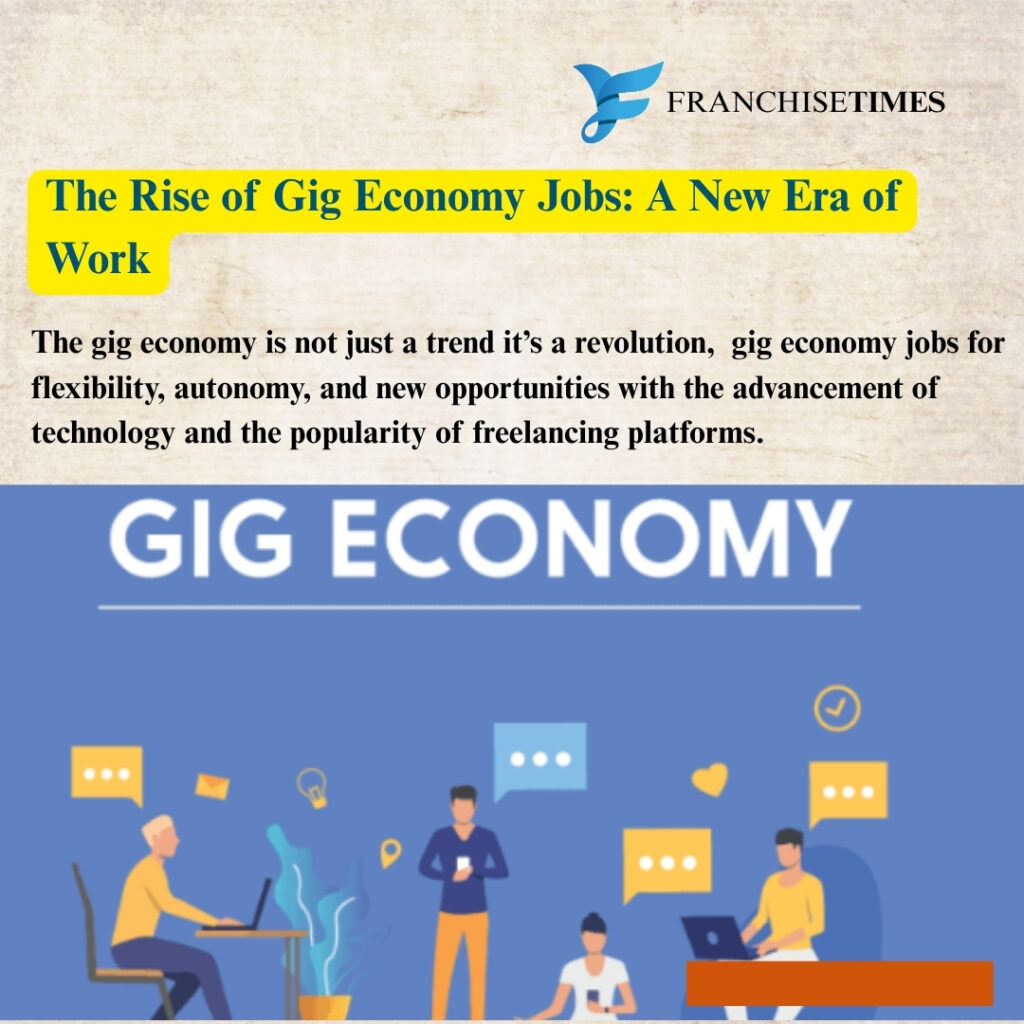The Rise of Gig Economy Job Trends: A New Era of Work
Over the past decade, the way people work has changed dramatically. The traditional 9-to-5 model is no longer the only path to a stable income. Instead, more individuals are turning to Gig Economy Job Trends for flexibility, autonomy, and new opportunities. With the advancement of technology and the popularity of freelancing platforms, the gig economy is not just a trend—it’s a revolution. In this blog, we’ll explore what gig economy jobs are, their pros and cons, and how to thrive in this fast-evolving sector.

What Are Gig Economy Jobs?
Gig Economy Job Trends refer to temporary, flexible work opportunities that are typically facilitated through digital platforms. Workers—often called freelancers, independent contractors, or gig workers—take on short-term assignments rather than committing to full-time employment with one employer.
Common examples include:
- Ride-sharing drivers (Uber, Lyft)
- Food delivery personnel (Swiggy, DoorDash)
- Freelance writers and graphic designers (Fiverr, Upwork)
- Virtual assistants
- Task-based workers (TaskRabbit)
These roles offer freedom and control, allowing individuals to choose when and how they want to work. However, it’s important to note that gig workers usually don’t receive benefits like health insurance or paid leave, which are typical in traditional employment.
Why Are Gig Economy Job Trends So Popular?
Several factors have contributed to the boom in Gig Economy Job Trends. First, the rise of smartphones and apps has made it easier than ever to connect workers with clients. People can now find work with a few taps on their screen.
Second, the demand for flexible work arrangements has increased. Many professionals prefer setting their own schedules and working from anywhere, especially after experiencing remote work during the pandemic.
Third, businesses are also benefiting from the gig model. Hiring freelancers helps companies reduce costs, increase efficiency, and quickly scale teams as needed—without long-term commitments.
Pros and Cons of Gig Economy Jobs
Like any employment model, gig economy jobs come with both advantages and disadvantages. Understanding them is crucial for anyone considering this path.
Pros:
- Flexibility: Choose your own hours and projects.
- Autonomy: Be your own boss.
- Multiple Income Streams: Work for different clients simultaneously.
- Skill Development: Gain experience across industries.
Cons:
- Lack of Benefits: No health insurance, retirement plans, or paid time off.
- Income Instability: Work is not always guaranteed.
- No Job Security: You may lose clients without warning.
- Self-Management Required: Handling taxes, invoices, and schedules can be overwhelming.
Still, for many people, the benefits outweigh the drawbacks—especially when gig work is used to supplement existing income or pursue passion projects.
Top Gig Economy Jobs in 2025
The landscape of Gig Economy Job Trends is always evolving. Here are some of the most popular and promising roles in 2025:
- Freelance Content Creator: With content being king, there’s high demand for writers, video editors, and graphic designers.
- App-Based Driver/Delivery Agent: Ride-sharing and food delivery remain reliable sources of income in urban areas.
- Virtual Assistant: Businesses need help with admin work, email management, and scheduling.
- Online Tutor: From academic subjects to language lessons, virtual teaching is in demand.
- Tech Freelancers: Developers, cybersecurity experts, and data analysts are thriving in gig setups.
- Fitness Coaches: Many trainers now offer virtual sessions or short-term fitness plans.
Thanks to platforms like Toptal, Freelancer.com, and LinkedIn, it’s easier than ever to find work in these areas. Moreover, specialized gig sites continue to emerge, catering to niches like pet care, housekeeping, and even mental wellness.
How to Succeed in Gig Economy Job Trends
If you’re looking to dive into gig economy jobs, preparation is key. Here’s how to get started and stand out:
- Build a Strong Online Profile: Your profile on freelancing platforms acts as your resume. Include samples, reviews, and a clear description of your services.
- Set Competitive Rates: Research the market and start with reasonable rates. As you gain experience, raise your fees.
- Stay Organized: Use tools like Trello, Google Calendar, or Notion to track tasks and deadlines.
- Improve Constantly: Take online courses, read industry blogs, and learn new skills to stay competitive.
- Communicate Clearly: Good communication builds trust and helps you retain clients.
Consistency, reliability, and professionalism are what turn one-time gigs into long-term partnerships. Moreover, always request feedback after completing a job—it boosts your credibility and rankings.
The Future of Gig Economy Jobs
The future of Gig Economy Job Trends looks promising but not without challenges. As technology continues to evolve, automation may eliminate some roles while creating others. Policymakers around the world are also debating whether gig workers should receive more legal protections, such as minimum wage guarantees and benefits.
At the same time, businesses are recognizing the value of on-demand talent, and workers appreciate the lifestyle that gig work supports. We may soon see hybrid models emerge—blending the flexibility of gig work with the stability of full-time employment.
Furthermore, with the rise of AI and digital tools, new gig roles are appearing in fields like prompt engineering, virtual companionship, and niche consulting. The scope for creative and knowledge-based gigs will only expand from here.
Gig Economy Jobs as a Long-Term Career Choice
While many people view gig economy jobs as temporary or supplemental, an increasing number are building long-term careers in the gig space. The flexibility and variety of work allow professionals to specialize, build a brand, and earn a sustainable income over time. For instance, freelance writers may start with basic blog posts but eventually move into high-paying copywriting or consulting roles. Similarly, graphic designers can evolve into brand strategists, expanding their service offerings and client base.
Another advantage of this career path is scalability. As a gig worker, you can eventually outsource tasks, create digital products, or launch your own agency. Many successful entrepreneurs today began as solo gig workers before growing into full-fledged businesses.
Ultimately, gig economy jobs offer more than just temporary income—they can be the foundation of a fulfilling and dynamic career. With the right strategies, dedication, and adaptability, gig work can become both professionally rewarding and financially viable in the long run.
Conclusion
Gig Economy Job Trends are reshaping the workforce, giving people more control over their time and income. While they’re not without drawbacks, they offer immense potential for those who value independence and variety in their work lives. Whether you’re looking to freelance full-time or simply earn extra cash on the side, the gig economy has a place for you. The key is to stay informed, adaptable, and proactive.
